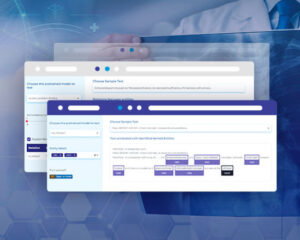Cancer is a complex disease characterized by the uncontrolled growth and spread of abnormal cells. It affects millions of people and is the second leading cause of death worldwide. Oncology, the study of cancer, is one of the most important fields in healthcare today as it helps diagnose, treat, and prevent cancer. Advancements in oncology have led to new treatment options such as immunotherapies, targeted therapies, and precision medicine that have improved patient outcomes and revolutionized cancer care.

Healthcare Natural Language Processing has emerged as a powerful tool in oncology research as it extracts and analyzes information from unstructured clinical text like pathology reports, electronic health records (EHRs), radiology reports, and clinical notes. This information can be used to identify associations, patterns, and trends that may not be apparent via traditional manual view. For instance, NLP in oncology can help identify patients with a high risk of cancer, and predict treatment outcomes.
In this article, we will discuss the significance and applications of NLP in Oncology.
Harnessing the Power of NLP in Oncology
In Oncology, Natural Language Processing can be used in various ways to improve cancer diagnosis, treatment, and patient outcomes. Below are the notable examples that depict how we can harness the power of NLP in oncology:
- NLP for Cancer Diagnosis – Natural language processing in oncology analyzes electronic health records and identifies patients at risk of cancer. It helps identify patients who have been exposed to various environmental risk factors, or have a family history of cancer. It analyzes mammography reports and identifies breast cancer characteristics such as tumor size, type, and location. It also analyzes radiology reports and identifies patients who are at risk of lung cancer based on their smoking history, age, and other risk factors.
- NLP for Clinical Trial Matching – NLP in oncology assists in matching cancer patients to appropriate clinical trials based on their genetic profile and medical history. For instance, it helps identify patients who meet eligibility criteria for a clinical trial and contact them to encourage participation. The process involves four steps: data extraction, eligibility criteria matching, trial identification, and patient outreach.
- NLP for Treatment Planning – NLP in oncology assists oncologists develop personalized treatment plans for cancer patients. It helps identify patients who are likely to respond to a specific treatment. It also assists oncologists in treatment monitoring by analyzing radiology reports and detecting changes in tumor shape and size, metabolic activity, or other relevant biomarkers over time.
- NLP for Drug Repurposing – Natural language processing in oncology can analyze large volumes of biomedical literature and clinical data to identify existing drugs that may be effective in treating cancer. The process involves four steps:
- Data collection – NLP algorithms extract relevant information from a variety of sources such as EHRs, scientific literature, and public databases of drug information.
- Data analysis – NLP algorithms analyze the extracted data to identify relationships, insights, and patterns relevant to cancer treatment.
- Drug selection – NLP algorithms generate a list of potential drug candidates that may be effective in treating cancer. The candidates may include both investigational drugs that are still in development and approved drugs that are used to treat other diseases.
- Experimental validation – This step is required to confirm the effectiveness of potential drug candidates in treating cancer. It may involve clinical trials, in vitro or in vivo studies, etc.
- NLP for Patient Communication – NLP in oncology helps improve patient communication and engagement in cancer care in various ways:
- Medical chatbots and virtual assistants can answer patient questions and offer emotional support.
- NLP can automatically extract relevant patient data and generate personalized educational resources to support patient understanding of their diagnosis, treatment, and self-care.
- Natural language processing for oncology can be used to improve the accuracy of clinical documentation, reduce medical errors, and ensure that patients receive appropriate care.
- NLP for exploring oncology notes with various models – In the field of oncology, the utilization of Natural Language Processing (NLP) techniques can greatly benefit the analysis of oncology notes and provide valuable insights. NLP models such as Spark NLP, Healthcare NLP, Assertion Status, and Relation Extraction offer powerful capabilities for detecting oncological terms, extracting relevant information, and establishing meaningful relationships within the text. The demo shows how oncological terms can be detected using NLP tools such as Spark NLP, Healthcare NLP, Assertion Status, and Relation Extraction models.
- NLP for identifying anatomical and oncology entities related to different treatments and diagnosis from clinical texts – NLP in oncology extracts more than 40 Oncology-related entities including those related to cancer diagnosis, staging information, tumors, lymph nodes, and metastases. It can also extract entities related to oncology therapies, mentions of treatments, posology information, tumor size, cancer therapies, and anatomical entities.
- NLP for identifying tests, biomarkers, and their results – In the field of oncology, Natural Language Processing (NLP) plays a pivotal role in extracting valuable information from oncology texts. Leveraging the power of NLP techniques, including Named Entity Recognition (NER) and information extraction, researchers and healthcare professionals can efficiently identify tests, biomarkers, and their results from clinical texts. By automatically extracting mentions of tests, NLP in oncology ensures that no vital diagnostic procedures are overlooked. Timely identification of pathology tests and imaging tests from clinical texts enables healthcare providers to follow the necessary protocols and accurately diagnose patients. NLP in oncology assists in streamlining clinical documentation processes by efficiently capturing mentions of biomarkers and their results from oncology texts.
- NLP for identifying demographic information from oncology texts – NLP in oncology extracts demographic information from oncology texts and provides several benefits. For instance, by analyzing patient demographic data, NLP enables clinicians to develop personalized treatment plans that take into account individual patient characteristics. Demographic data can also be used to identify patient populations for clinical research studies that can help improve cancer treatment and outcomes. The demo shows how NLP can extract demographic information, age, gender, and smoking status from oncology texts.
- NLP for detecting assertion status from clinics entities – NLP in oncology helps detect the assertion status of oncological entities (including diagnoses, therapies, and tests), and if a demographic entity refers to the patient or someone else. By identifying the assertion status of entities, clinicians can make more informed treatment decisions. For instance, a disease (entity) marked as “present” warrants more immediate treatment than a disease marked as “possible”.
- NLP for detecting relation extraction between different oncological entity types – NLP in oncology analyzes the relationship between different oncological entities in clinical notes, helping patients receive appropriate care and treatment. For instance, if a symptom is found to be strongly associated with a specific diagnosis, it may indicate the need for immediate testing or a more aggressive treatment approach. The demo shows how NLP can identify relations between clinical entities, tumor mentions, anatomical entities, tests, biomarkers, anatomical entities, tumor size, tumor finding, and date.
- NLP for resolving oncology terminology using the ICD-O taxonomy – By resolving oncology terminology using this taxonomy, NLP for oncology helps ensure that the patient data is accurately coded and classified, reducing the risk of errors in diagnosis, treatment, and research. The demo shows that the model maps oncology terminology to ICD-O codes using entity resolvers.
NLP in Oncology: In a Nutshell
In this article, we discussed the importance of Oncology in healthcare that improves patient outcomes, reduces cancer-related deaths and healthcare costs. Natural Language processing is playing a crucial role in oncology as it extracts meaningful information from unstructured data such as clinical notes, radiology and pathology reports, which can assist in cancer diagnoses, treatment, and research.
NLP in oncology identifies patients at risk of cancer, develops personalized treatment plans, matches patients to appropriate clinical trials, and identifies drugs that may be effective in treating cancer. It also identifies tests, biomarkers, demographic information from oncology texts, and helps detect the assertion status of clinical entities.
John Snow Labs’ Healthcare NLP gives voice to the unstructured data of the healthcare universe, transforms it into a useful format, and leverages it for boosting outcomes.
Get started here and see which Oncology-related Demo can be best applied to your use case.





































